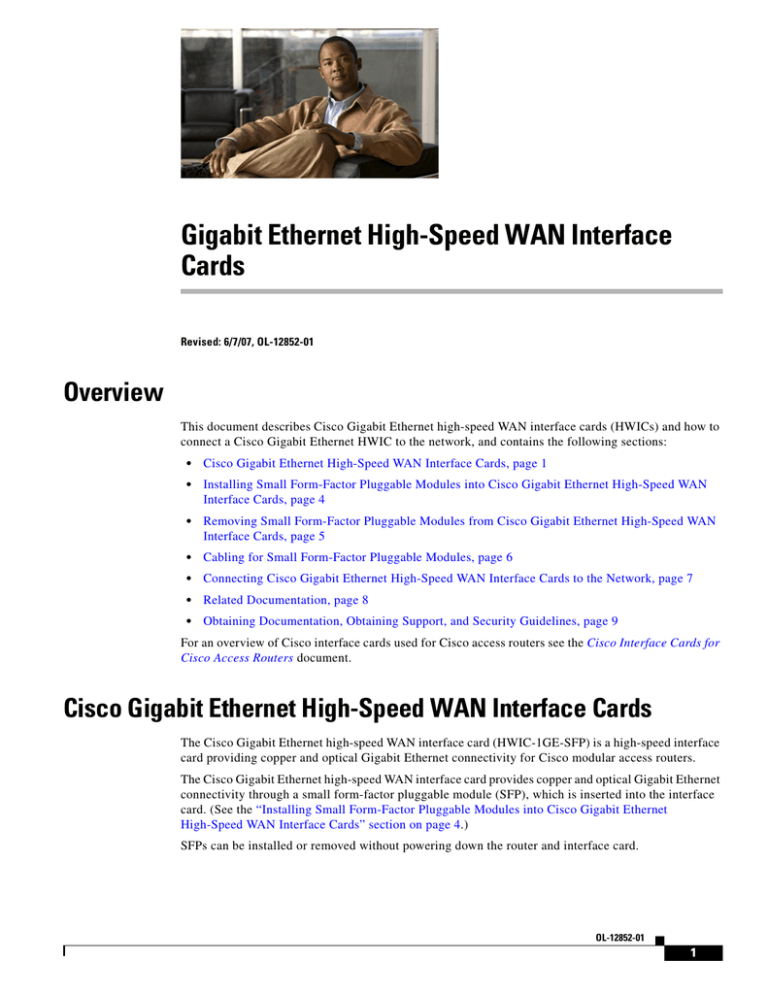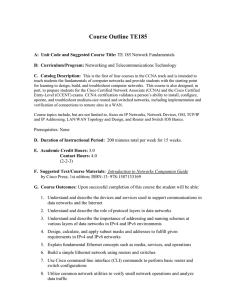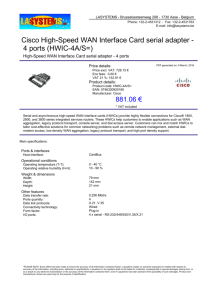
Gigabit Ethernet High-Speed WAN Interface
Cards
Revised: 6/7/07, OL-12852-01
Overview
This document describes Cisco Gigabit Ethernet high-speed WAN interface cards (HWICs) and how to
connect a Cisco Gigabit Ethernet HWIC to the network, and contains the following sections:
•
Cisco Gigabit Ethernet High-Speed WAN Interface Cards, page 1
•
Installing Small Form-Factor Pluggable Modules into Cisco Gigabit Ethernet High-Speed WAN
Interface Cards, page 4
•
Removing Small Form-Factor Pluggable Modules from Cisco Gigabit Ethernet High-Speed WAN
Interface Cards, page 5
•
Cabling for Small Form-Factor Pluggable Modules, page 6
•
Connecting Cisco Gigabit Ethernet High-Speed WAN Interface Cards to the Network, page 7
•
Related Documentation, page 8
•
Obtaining Documentation, Obtaining Support, and Security Guidelines, page 9
For an overview of Cisco interface cards used for Cisco access routers see the Cisco Interface Cards for
Cisco Access Routers document.
Cisco Gigabit Ethernet High-Speed WAN Interface Cards
The Cisco Gigabit Ethernet high-speed WAN interface card (HWIC-1GE-SFP) is a high-speed interface
card providing copper and optical Gigabit Ethernet connectivity for Cisco modular access routers.
The Cisco Gigabit Ethernet high-speed WAN interface card provides copper and optical Gigabit Ethernet
connectivity through a small form-factor pluggable module (SFP), which is inserted into the interface
card. (See the “Installing Small Form-Factor Pluggable Modules into Cisco Gigabit Ethernet
High-Speed WAN Interface Cards” section on page 4.)
SFPs can be installed or removed without powering down the router and interface card.
OL-12852-01
1
Gigabit Ethernet High-Speed WAN Interface Cards
Cisco Gigabit Ethernet High-Speed WAN Interface Cards
Caution
Note
To comply with the Telcordia GR-1089 NEBS standard for electromagnetic compatibility and safety,
connect the Gigabit Ethernet high-speed WAN interface card (HWIC-1GE-SFP) only to intra-building
or non-exposed wiring or cabling. The intrabuilding cable must be shielded and the shield must be
grounded at both ends.
The Cisco Gigabit Ethernet high-speed WAN interface card itself is not hot-swappable. Removal or
insertion of the Cisco Gigabit Ethernet high-speed WAN interface card requires powering down the
router.
The Cisco Gigabit Ethernet high-speed WAN interface card supports the SFPs shown in Table 34.
Table 34
SFPs Supported on the Cisco Gigabit Ethernet High-Speed WAN Interface Card
(HWIC-1GE-SFP)
GE SFP Transceiver Type Cisco Part Number
Wavelength
Maximum Distance
1000BASE-T
GLC-T=
n/a
100 m
1000BASE-SX
GLC-SX-MM=
850 nm
500 m
1000BASE-LX/LH
GLC-LH-SM=
1310 nm
10 km
1000BASE-ZX
GLC-ZX-SM=
1550 nm
80 km
1000BASE-CWDM
CWDM-SFP-1470=
1470 nm
100 km
CWDM-SFP-1490=
1490 nm
CWDM-SFP-1510=
1510 nm
CWDM-SFP-1530=
1530 nm
CWDM-SFP-1550=
1550 nm
CWDM-SFP-1570=
1570 nm
CWDM-SFP-1590=
1590 nm
CWDM-SFP-1610=
1610 nm
Note
Only Cisco-certified SFPs are supported on the Cisco Gigabit Ethernet high-speed WAN interface card.
Tip
When switching from one type of SFP to another, connection problems, including connection failure,
may result. Use the show controller command at the Cisco IOS command-line interface (CLI) to
determine whether you are using an SFP certified by Cisco.
Different SFPs have different cabling requirements; see the “Cabling for Small Form-Factor Pluggable
Modules” section on page 6 for more information on SFP cabling.
OL-12852-01
2
Gigabit Ethernet High-Speed WAN Interface Cards
Cisco Gigabit Ethernet High-Speed WAN Interface Cards
Laser Safety Guidelines
Optical SFPs use a small laser to generate the fiber-optic signal. Keep the optical transmit and receive
ports covered whenever a cable is not connected to the port.
The interface card faceplate carries a Class 1 laser warning label. (See Figure 115.)
Figure 115
Class 1 Laser Warning Label
CLASS 1 LASER PRODUCT
LASERPRODUKT DER KLASSE 1
PRODUIT LASER DE CLASSE 1
PRODUCTO LASER CLASE 1
1
EN
LINK
TX
RX
103083
HWIC1GE-SFP
CLASS 1 LASER PRODUCT
LASERPRODUKT DER KLASSE 1
PRODUIT LASER DE CLASSE 1
PRODUCTO LASER CLASE 1
1
GE 0
Warning
Because invisible laser radiation may be emitted from the aperture of the port when no fiber cable is
connected, avoid exposure to laser radiation and do not stare into open apertures. Statement 125
Warning
Ultimate disposal of this product should be handled according to all national laws and regulations.
Statement 1040
Cisco Gigabit Ethernet High-Speed WAN Interface Card LEDs
The Cisco Gigabit Ethernet high-speed WAN interface card uses LEDs to indicate card status and
activity. (See Figure 116.)
Figure 116
CLASS 1 LASER PRODUCT
LASERPRODUKT DER KLASSE 1
PRODUIT LASER DE CLASSE 1
PRODUCTO LASER CLASE 1
1
EN
LINK
TX
RX
1
2
3
4
GE 0
103082
HWIC1GE-SFP
Cisco Gigabit Ethernet High-Speed WAN Interface Card Faceplate (HWIC-1GE-SFP)
1
EN: When green, indicates that the interface
card is available to the router.
2
LINK: When green, indicates that the
connection is available to the router.
3
TX: When green, indicates that the interface
is transmitting data to the network.
4
RX: When green, indicates that the interface
is receiving data from the network.
OL-12852-01
3
Gigabit Ethernet High-Speed WAN Interface Cards
Installing Small Form-Factor Pluggable Modules into Cisco Gigabit Ethernet High-Speed WAN Interface Cards
Installing Small Form-Factor Pluggable Modules into Cisco
Gigabit Ethernet High-Speed WAN Interface Cards
Small form-factor pluggable modules (SFPs) are hot-swappable Ethernet interfaces that can be installed
directly into the Cisco Gigabit Ethernet high-speed WAN interface card. See Table 34 for SFPs
supported on the Cisco Gigabit Ethernet high-speed WAN interface card.
To install an SFP into the Cisco Gigabit Ethernet high-speed WAN interface card, perform the following
steps:
Step 1
Install the interface card in the router. (See Chapter , “Installing Cisco Interface Cards in Cisco Access
Routers.”)
Warning
Because invisible laser radiation may be emitted from the aperture of the port when no fiber cable is
connected, avoid exposure to laser radiation and do not stare into open apertures. Statement 125
Step 2
Slide the SFP into the housing on the interface card until it is locked into position. (See Figure 117.) The
SFP is designed to prevent improper insertion.
Tip
If the SFP uses a bale-clasp latch (see Figure 117 and Figure 118), the bale-clasp handle should be on
top of the SFP in the closed position for proper seating of the SFP module.
Installing an SFP on the Cisco Gigabit Ethernet High-Speed WAN Interface Card
HWIC
1GE-SFP
CLA
S
LAS S 1 LAS
E
PRO RPROD ER PR
PRODUIT LA UKT D ODUCT
E
DUC SER
DE R KLAS
TO
1 LASER CLASSE SE 1
CLA 1
SE 1
EN
1
1
TX
RX
GE 0
Optical port plug
Caution
Do not remove the optical port plugs used on the SFP until you are ready to connect cabling to the
interface card.
Caution
To comply with the Telcordia GR-1089 NEBS standard for electromagnetic compatibility and safety,
connect the Gigabit Ethernet high-speed WAN interface card (HWIC-1GE-SFP) only to intra-building
or non-exposed wiring or cabling. The intrabuilding cable must be shielded and the shield must be
grounded at both ends.
OL-12852-01
4
LINK
122213
Figure 117
Gigabit Ethernet High-Speed WAN Interface Cards
Removing Small Form-Factor Pluggable Modules from Cisco Gigabit Ethernet High-Speed WAN Interface Cards
Step 3
Connect the interface card to the network. (See the “Connecting Cisco Gigabit Ethernet High-Speed
WAN Interface Cards to the Network” section on page 7.)
Removing Small Form-Factor Pluggable Modules from Cisco
Gigabit Ethernet High-Speed WAN Interface Cards
This section describes a generic removal procedure. Small form-factor pluggable modules (SFPs) use
various latch designs (see Figure 118) to secure the module in the SFP port.
Note
Latch designs are not linked to SFP model or technology type; for information on the SFP technology
type and model, see the label on the top or side of the SFP.
Removing SFPs from Cisco Gigabit Ethernet High-Speed WAN Interface Cards
To remove an SFP from a Cisco Gigabit Ethernet high-speed WAN interface card, perform the following
steps:
Step 1
Disconnect all cables from the SFP.
Warning
Because invisible laser radiation may be emitted from the aperture of the port when no fiber cable is
connected, avoid exposure to laser radiation and do not stare into open apertures. Statement 125
Caution
The latching mechanism used on many SFPs locks the SFP into place whenever cables are connected.
Do not pull on the cabling in an attempt to remove the SFP.
Step 2
Figure 118
Disconnect the SFP latch (see Figure 118).
Disconnecting SFP Latch Mechanisms
1
2
3
4
A
117722
B
OL-12852-01
5
Gigabit Ethernet High-Speed WAN Interface Cards
Cabling for Small Form-Factor Pluggable Modules
1
Sliding latch
2
Swing and slide latch
3
Bale-clasp latch
4
Plastic collar latch
Tip
Step 3
Use a pen, screwdriver, or other small, straight tool to gently release the bale-clasp handle if you cannot
reach it with your fingers.
Grasp the SFP on both sides and remove it from the interface card.
Cabling for Small Form-Factor Pluggable Modules
Cisco Gigabit Ethernet high-speed WAN interface cards connect to the network through various
supported small form-factor pluggable modules (SFPs). Cabling requirements vary by SFP. See the
“Cabling for Small Form-Factor Pluggable Modules” section on page 6.
For information on cabling requirements for various small form-factor pluggable modules (SFPs)
supported by the Cisco Gigabit Ethernet high-speed WAN interface card, see Table 35.
Table 35
Cabling Requirements for Gigabit Ethernet Small Form-Factor Pluggable Modules
GE SFP Transceiver
Type
Cisco Part Number
Maximum Distance Cabling Required
1000BASE-T
GLC-T=
100 m
1000BASE-SX
1000BASE-LX/LH
GLC-SX-MM=
GLC-LH-SM=
Connector Type
Category 5, 5e, 6
RJ-45
1
300 m
62.5/125 micrometer MMF
500 m
50/125 micrometer MMF
550 m
50/125 micrometer or 62.5/125
micrometer MMF
10 km
9/125 micrometer SMF2
LC connector
LC connector
1000BASE-ZX
GLC-ZX-SM=
80 km
9/125 micrometer SMF
LC connector
1000BASE-CWDM
CWDM-SFP-1470=
CWDM-SFP-1490=
CWDM-SFP-1510=
CWDM-SFP-1530=
CWDM-SFP-1550=
CWDM-SFP-1590=
CWDM-SFP-1610=
100 km
9/125 micrometer SMF
LC connector
1. MMF = multimode fiber
2. SMF = singlemode fiber
OL-12852-01
6
Gigabit Ethernet High-Speed WAN Interface Cards
Connecting Cisco Gigabit Ethernet High-Speed WAN Interface Cards to the Network
LC Connector
121498
Figure 119
Note
Coarse wavelength-division multiplexing (CWDM) SFP transceivers are color-coded based on
wavelength: gray (1470), violet (1490), blue (1510), green (1530), yellow (1550), orange (1570), red
(1590), and brown (1610).
Cisco Gigabit Ethernet high-speed WAN interface cards are designed for use in the following network
design scenarios:
Tip
•
In metropolitan-area network (MAN) backbones for low-cost, high-speed, and long-distance
connectivity
•
In multiprotocol WAN gateway routers for LANs
•
In same-building or same-campus wiring closets to achieve high-speed connectivity for
high-demand network segments
For more information on possible network configurations using the Cisco Gigabit Ethernet high-speed
WAN interface card, see Cisco product documentation.
Connecting Cisco Gigabit Ethernet High-Speed WAN Interface
Cards to the Network
To connect the Cisco Gigabit Ethernet high-speed WAN interface card to the network, perform the
following steps:
Step 1
Warning
Confirm successful insertion of the SFP.
Because invisible laser radiation may be emitted from the aperture of the port when no fiber cable is
connected, avoid exposure to laser radiation and do not stare into open apertures. Statement 125
Step 2
Confirm that the router is powered down.
Step 3
Remove optical port plugs from the installed SFP.
Step 4
Use the appropriate cable (see Table 35) to connect to the installed SFP.
Note
For short distances or loopbacks, network installations using 1000BASE-CWDM and
1000BASE-ZX SFPs may require 15-dBm attenuators to avoid over-powering the connection.
Calculate the power budget for the connection to determine which attenuator to use.
OL-12852-01
7
Gigabit Ethernet High-Speed WAN Interface Cards
Related Documentation
Step 5
For network installations that use 1000BASE-CWDM SFPs, connect the SFP to a Cisco CWDM optical
add-drop multiplexing (OADM) interface card. (See Figure 120.) For information on the Cisco CWDM
OADM, see the Installation Note for the Cisco CWDM Passive Optical System document.
Figure 120
Using a Cisco CWDM OADM Card to Connect the Cisco Gigabit Ethernet High-Speed
WAN Interface Card to the Network
HWIC1GE-SFP
HWIC-1GE-SFP
CLASS
1
LASERP LASER PROD
PRODUITRODUKT DER UCT
PRODUC LASER DE CLAKLASSE 1
TO LASE
SS
R CLAS E 1
1
E1
EN
LINK
TX
LC connector
RX
GE 0
CWDM
SFP
117367
Dual
Single-Channel
OADM module
To Network
To Network
Step 6
Connect the other end of the appropriate cable (see Table 35) to your network.
Step 7
Continue router startup and configuration tasks.
Related Documentation
Related documentation is available on Cisco.com or on the Product Documentation DVD. For more
information, see the “Obtaining Documentation, Obtaining Support, and Security Guidelines” section
on page 9.
•
Cisco Gigabit Ethernet High-Speed WAN Interface Card for Cisco 2800 and 3800 Series Routers,
data sheet
•
Cisco Gigabit Ethernet High-Speed WAN Interface Card, Q&A
•
Cisco Network Modules and Interface Cards Regulatory Compliance and Safety Information
•
“Configuring LAN Interfaces” chapter of the Cisco IOS Interface Configuration Guide,
Release 12.2
OL-12852-01
8
Gigabit Ethernet High-Speed WAN Interface Cards
Obtaining Documentation, Obtaining Support, and Security Guidelines
Obtaining Documentation, Obtaining Support, and Security
Guidelines
For information on obtaining documentation, obtaining support, providing documentation feedback,
security guidelines, and also recommended aliases and general Cisco documents, see the monthly
What’s New in Cisco Product Documentation, which also lists all new and revised Cisco technical
documentation, at:
http://www.cisco.com/en/US/docs/general/whatsnew/whatsnew.html
CCVP, the Cisco logo, and Welcome to the Human Network are trademarks of Cisco Systems, Inc.; Changing the Way We Work, Live, Play, and Learn is
a service mark of Cisco Systems, Inc.; and Access Registrar, Aironet, Catalyst, CCDA, CCDP, CCIE, CCIP, CCNA, CCNP, CCSP, Cisco, the Cisco
Certified Internetwork Expert logo, Cisco IOS, Cisco Press, Cisco Systems, Cisco Systems Capital, the Cisco Systems logo, Cisco Unity,
Enterprise/Solver, EtherChannel, EtherFast, EtherSwitch, Fast Step, Follow Me Browsing, FormShare, GigaDrive, HomeLink, Internet Quotient, IOS,
iPhone, IP/TV, iQ Expertise, the iQ logo, iQ Net Readiness Scorecard, iQuick Study, LightStream, Linksys, MeetingPlace, MGX, Networkers,
Networking Academy, Network Registrar, PIX, ProConnect, ScriptShare, SMARTnet, StackWise, The Fastest Way to Increase Your Internet Quotient,
and TransPath are registered trademarks of Cisco Systems, Inc. and/or its affiliates in the United States and certain other countries.
All other trademarks mentioned in this document or Website are the property of their respective owners. The use of the word partner does not imply a
partnership relationship between Cisco and any other company. (0711R)
Any Internet Protocol (IP) addresses used in this document are not intended to be actual addresses. Any examples, command display output, and
figures included in the document are shown for illustrative purposes only. Any use of actual IP addresses in illustrative content is unintentional and
coincidental.
© 2007 Cisco Systems, Inc. All rights reserved.
OL-12852-01
9
Gigabit Ethernet High-Speed WAN Interface Cards
Obtaining Documentation, Obtaining Support, and Security Guidelines
OL-12852-01
10




